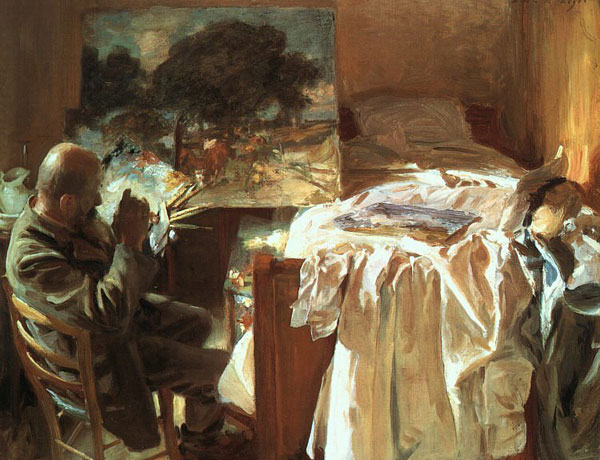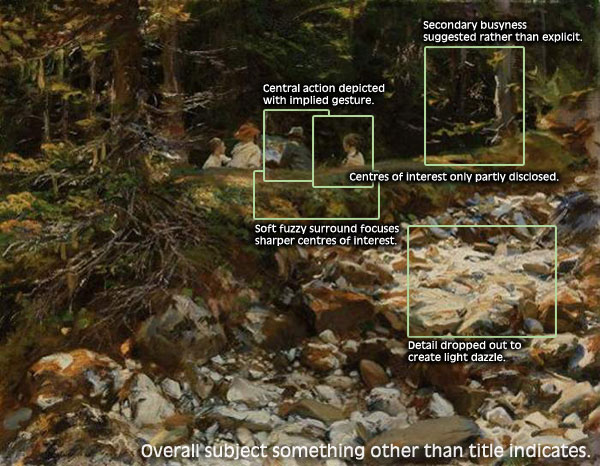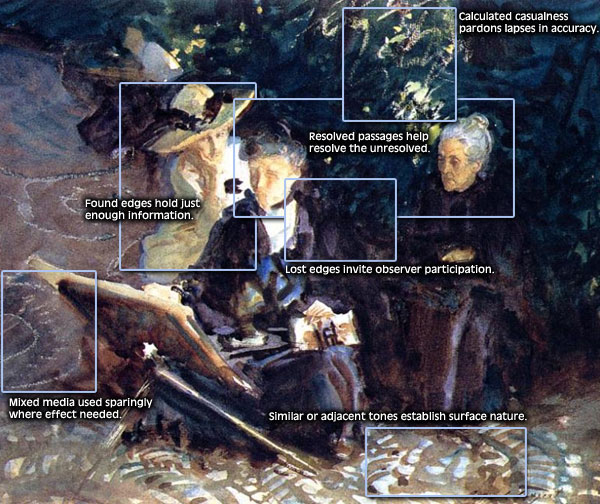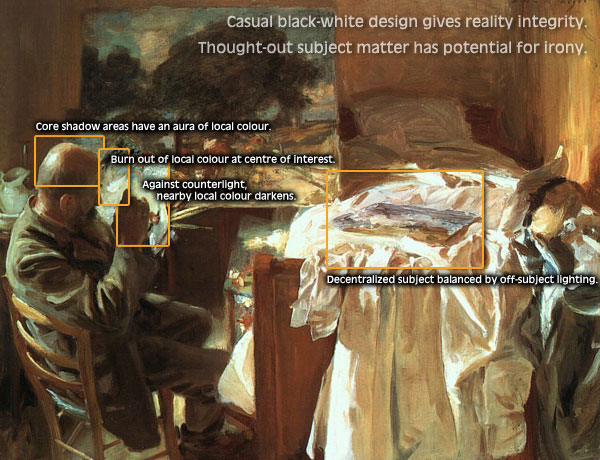Dear Artist,
Work can be made masterful with a heightened sense of observation and a willingness to convey. It’s a matter of picking up on what may seem to be small bits of information. Many painters look but do not see. Others see but choose not to include — and that’s okay, too. For this exercise I took three paintings by John Singer Sargent — two oils and a watercolour — and identified 18 information bits that undoubtedly went through Sargent’s head (consciously or unconsciously — mostly the former I think) when he painted them. To bring them more to life and to aid in the understanding of those readers who might be interested, I’ve asked Andrew to put up the three paintings below. I’ve also asked him to feature close-ups of the areas I’m talking about. See below.
From The Master and his Pupils, 1914, oil, 22″ x 28″: Soft fuzzy surround focuses sharper centres of interest. Secondary busyness suggested rather than explicit. Detail dropped out to create light dazzle. Centre of interest only partly disclosed. Central action depicted with implied gesture. Overall subject something other than title indicates.
From In the Generalife, 1912, Watercolour, 15″ x 17″: Similar or adjacent tones establish surface nature. Resolved passages help resolve the unresolved. Lost edges invite observer participation. Found edges hold just enough information. Calculated casualness pardons lapses in accuracy. Mixed media used sparingly where effect needed.
From Artist in his Studio, 1903, Oil, 28″ x 28″: Casual black-white design gives reality integrity. Decentralized subject balanced by off-subject lighting. Burn out of local colour at centre of interest. Against counterlight, nearby local colour darkens. Core shadow areas have an aura of local colour. Thought-out subject matter has potential for irony.
In cruising the work of masters, the prepared observer can find examples of this sort of info. For those who are willing to push themselves, information, properly processed, rings the precious bell of truth. As well as observation, it takes work. “Mine is the horny hand of toil.” (John Singer Sargent)
Best regards,
Robert
PS: “In the fields of observation chance favors the prepared mind.” (Louis Pasteur) “Observation and study are necessary to achieve mastery of light and form.” (Andrew Loomis) “Observation and reasoning lead to truth.” (Alexis Carrel)
Esoterica: A good way to approach information assembly is to choose a concept that is dear to your heart. Take, for example, “gradation.” Look at subject matter — either live or canned — and carefully canvas it for gradation opportunities. As you work, keep asking yourself where further gradations might be effective. After a while you will be turning on your “gradation mind” at will, seeing and building gradations in spades. This works for all concepts — negative areas, warm against cool, adjacent areas accepting temperature, and other pictorial information.
Pictorial information in paintings by J. S. Sargent (1856-1925)
What is not seen
by Duane Dorshimer, Raleigh, NC, USA
For me this Pictorial Information letter has been the best yet! Your interpretation of Sargent’s intention with his works gave me an “Ah HA!” moment. I saw a connection between how a painting’s visual organization can impact how a viewer feels about the subject. What this means to me is sometimes the best way to get a viewer involved in the subject may be to partly obscure it — not put it right out and front. I always wondered why Andrew Wyeth’s works had such an emotional impact on me. My example: Christina’s World. I first saw that painting outside the Principals’ office in Elementary school. Even as a child, the work evoked strong feelings. What I did not see became more important than what I did. I wanted to know why that girl was in that field.
(RG note) Thanks, Duane, and thanks to all who wrote to say that my little attempt to illustrate what was going on in an artist’s head was worthwhile. And thanks to Andrew for working out a way to show it. We’ll do it again sometime.
It’s in the details
by Brad Greek, Mary Esther, FL, USA
I’ve always felt that a painting should have a story. Maybe this was developed when in school and looking at illustrations in the history books. For me it is a must, to have those small details that, if studied enough, will come clear to the viewer and then will always be a part of their view of that piece from then on. Then there are always those gems that appear after the piece is completed that you didn’t consciously put in there.
Puzzled by unfinished quality
by Mary Jean Mailloux, Oakville, ON, Canada
When looking at the three Sargent paintings, I find a distinctly different quality in the middle one. I don’t know if it is the very black against the very white, but the other two seem finished while the middle one seems sketchy. Why are two of the faces completed with details where the one in the foreground is vague and featureless?
(RG note) Thanks, Mary Jean. The unresolved central face has always interested me. My point is that Sargent used calculated casualness to carry the day in this painting. If the whole watercolour had been “tight” it would not have been possible to get away with the lack of definition in the central character. It’s a sketch and therein lies its charm. In the recent painting Silent Village that I set out as a work in progress, several artists wrote to tell me that
Questions about gradations
by Sally Pollard, Weiser, ID, USA
Thanks very much for your analysis of the thinking of John Singer Sargent. Since you often work in acrylics and are talking gradations… do you mix several values and lay them on, use thin layers or lots of medium? The casualness is the klinker factor.
(RG note) Thanks, Sally, and thanks to everybody who asked about gradations. Casualness is the operative word. I believe in gradations and if I can pull them off with one swipe I do and let them be. Otherwise I fiddle them up. A nice way to make gradations for large areas is to pre-mix both ends of the gradation, put them down and wetly feather the area where they meet. Lots of medium. In watercolour excellent effects can be made by puddling-up and hitting one end or the other with a loaded brush-tip of the end-tone.
Keeping a light awareness
by Becky McMahon, Surrey, BC, Canada
What you describe as a state of unknowing is somewhat the same when I play a tune I know very well. I can let my fingers play it without consciously thinking about what I’m doing. Muscle memory is the key. The flip side is that if I do change my level of consciousness I can easily lose my place since I’m not aware of what my fingers are doing. When I paint I find that many of my best pictures happen when I just let my brush go and keep a light awareness of what I’m doing. Often it’s the first or second try at a subject that is the best, because I haven’t tried to ‘fix’ things. I do Chinese Brush painting so if I don’t get it right I just move on to the next painting. It frees me from being too tight.
Value of sketches
by Alev Oguz, Istanbul, Turkey
Sketching is an indispensable tool. It is taking short notes of value, color and mood observations. Preliminary studies help solving the compositional matters and warming up. It sure is time consuming but it’s still much better than getting an unpleasant surprise half way through the real work. However, one may lose interest of the subject with excessive sketching. Leave some room for the final touch of spice. And if bored, leave it as a study and go for a new subject.
Art comes naturally
by Kim Connor, Winter Haven, FL, USA
I will never turn back now. I know that painting is a part of me and that I should have been doing this all along. I really do have pretty good talent for a beginner, but it is more than that. It is truly such a source of enjoyment, satisfaction, joy and release and lots of fun. I have learned great pointers and tips from my teacher but I must admit that most of what I do comes out so naturally, without any push or pull. Oh I just love it and I am hungry to learn and create more!
Higher level of being
by Meenal Chaudhari, Bangalore, India
I am a psychologist and an artist who is very interested in research into consciousness. I am even more interested in the little mental lapses where the mind is still but one remains conscious of what one is doing. There is no control being exercised. One is working in auto-pilot yet one remains completely aware of what is going on, without being identified with the act of painting. This state of no-thought is regarded in most Eastern cultures as a highly productive state. This is when the individual consciousness is said to be in direct connection with the Universal Creative Force. The artist then becomes more like a channel for the creative fountain–with the smaller ego voices becoming silent, it feels like a mental lapse, but it might be more like the personality of the artist takes a rest and the transpersonal and universal creativity finds an unimpeded outlet. It is a higher level of being.
Dared to paint better
by Jamie Lavin, Gardner, KS, USA
I spent Sunday looking around at the National Cowboy & Western Heritage Museum in Oklahoma City this past weekend. All who exhibit there are premier talents in the Art of the American West. Most of the most famous and revered painters and sculptors are displayed here: Remington, Russell, Hurley, Bierstadt. I realize I may have been looking into the masters’ desire as well as their mechanics. Undoubtedly, there is a sense of romance about the old west here in the building, but the paintings and sculptures carry their own weight. This is where the 5 huge triptychs by Wilson Hurley reside. Any artist, who wishes to know how great their legacy can be, should they want to try hard enough, need only see these remarkable suites. You leave the rather unlit and unremarkable room (with the huge exception to the paintings, each suite is about 30′ by 50′) overwhelmed by their beauty and accuracy, completely unbound by their sheer size (who makes canvas that big?) and totally ego-less after the viewing experience. Whoever thought to challenge Hurley to do such a project should have received a million dollars just for the thought. Viewing these pieces, delivered to the Hall in 1996, I’m sure would be tantamount to standing in front of a tidal-wave. I was completely “washed away” by their virtuosity. They stand before you, daring you to ever paint better. You back away from the images in a hope to see them better, yet it does not matter where your vantage point is. You can see them close up (hoping they don’t pick now to fall off the wall upon you) or you can stand back 110 feet or so, and drink in their ominous sight. You know after about 10 minutes in front of them, that you are before one of America’s greatest treasures; that a man envisioned and created these images based on what he saw, and that the mother-load of desire to execute these images was beyond what most people ever experience. I walked out of the room on fire, my chest heaving with a sense of purpose, my hands clenched for lack of a brush, my head engrossed with what I had seen. I absent-mindedly trundled along by the hand of my daughter, who asked the information lady if she had my ego behind the counter there, knowing it would take too long to build another.
Wilson Hurley had three careers in his lifetime, and each one gained him respect. His earliest desire was to paint, which he came to allow himself after his military and law careers.
Art gallery framing problem
by Doreen Shann, Kalamazoo, MI, USA
I recently moved to a new location and have been accepted into what appears to be a very prestigious gallery. He has a lot of top artists. He’s got Dalhart Windberg’s work, so he must be a pretty okay guy. Anyway, he wanted me to reframe my pieces as I only had gallery frames for juried shows. When I take these, what should I get from him in the way of a “contract” and what should I expect from him in writing? He takes 50%. I have been painting 5 years and have had a lot of success getting into juried shows and picking up prizes. I do pastels and love the medium. I would paint a lot more, but have to sell some work as we only live in a small place and don’t have storage, plus I need the money.
(RG note) Thanks, Doreen. We have three clickbacks that deal with gallery etiquette: Selling your art, Dealer loyalty and Gallery Blues. With regard to your framing situation, gross up the value of the frame to more than double your cost so you are at least getting your money back when he sells your frame. This practice tends to drive dealers to supply their own frames, which is the way it should be and is the case in many galleries — even with pastels. They make more money that way, they won’t damage your frames, and they can better suit the taste of the buyers in their community.
Giclee information
by Steve Easterwood, Montana, USA
What qualifies as a giclee as a limited edition print? I know an artist who runs copies of his watercolors on high quality paper through an ink-jet printer. He says they are just as high in quality as the ones he ordered from a professional company. What is your opinion?
(RG note) Last summer we tested photocopies done on our excellent Epson Stylus 1200 inkjet copier under bright sunlight over several days. They faded rather quickly and didn’t do as well as commercially produced giclees. Information and exchanges on giclee printing can be found on our site: Giclee prints and Giclée printmaking for artists.
Rapidly morphing world
by Brian Oschwald, Mendham, NJ, USA
I’ve done some considerable reading back over your philosophical musings in the Twice-Weekly Letters and I come away feeling that you’re leaving the gritty problem areas of art practice that involve Civics and social-political moral sentience out of the discussion. I wonder if you resonate personally with the multiple issues regarding contrasting types of Art Practices as these relate to social engagement with the world as it is, not just in the idealized Landscape forms that seem to appeal to visual artists of a stripe (painters mostly). Can you point to specific pieces of your writing that I’ve missed where you put your stake in the ground concerning the moral-intellectual rectitude of Professional Art Practice as it critically engages the world rapidly morphing before us?
(RG note) Nope.
(Andrew Niculescu note) All Robert’s letters from the year 2000 to present can be accessed free from our Letters Archive.
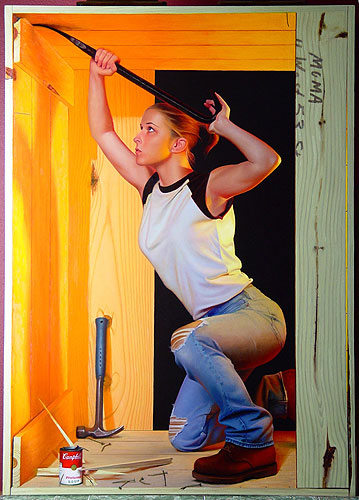
Deconstructionist oil painting |
You may be interested to know that artists from every state in the USA, every province in Canada, and at least 105 countries worldwide have visited these pages since January 1, 2005.
That includes Lea Magruder who wrote, “I am a painter and a pianist. The easier the piano piece, the more space to “think,” hear the noise of my inner critic, and self-sabotage. In difficult passages I find it best to zone out and let my inner musician (the artist) take over.”



